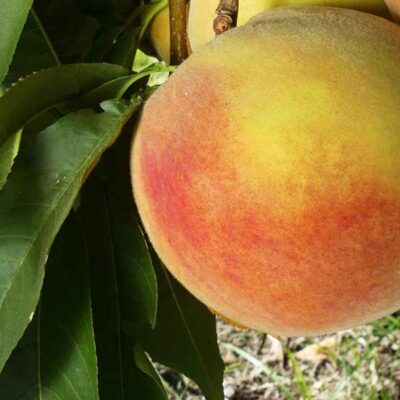Garden Plant: Early Elberta Peach Tree
Product Description: Early Elberta Peach Tree

Add Tasty Early Elberta Peach Tree
- Mid-Season
- 750 Chill Hours
- Freestone Peach
- Self-Pollinating
- Wonderful Heritage Variety
- Versatile in a Wide Range of Hardiness Zones
- Ripens About Two Weeks Earlier Than Elberta
- Very Sweet, Juicy Peach
- Large Harvests
- Fresh Eating, Freezing and Canning
- Pink Flowers in Spring
You really haven’t lived until You’ve enjoyed tree-ripe Elberta-style peach fresh from the tree. If it’s thriving on your property, all the better!
But did you know there is an early ripening Elberta variety? These time-tested fruit trees have a million nicknames, with variations on Early Improved Alberta, to Gleason and July Early Elberta and Kim Early Elberta. Even the name Goldfinch is included in that lineup.
Whatever you call this variety, just don’t be late for dinner. This productive tree makes incredible fruit that can be enjoyed fresh, canned or frozen to be baked into sumptuous pies and cobblers later in the year.
These special heritage trees are the heart and soul of American backyard peach fruit culture. With a fine texture and bright, golden flesh, Early Elberta (Prunus persica \’Early Elberta) is a great-tasting mid-season treat.
The trees, originally a sport of Elberta, are big producers, so You’ll have plenty on hand to share and enjoy. We’re talking up to 150 pounds on a single, self-pollinating tree.
The tree produces fruit that is yellow-skinned fruit with a slight red blush. It ripens about two weeks earlier than Elberta.
Add one of each to your edible landscape and enjoy a month of harvest. Extend the fresh eating season even further with a Fay Elberta tree.
Make Clara Elberta (the original namesake) proud. Get started on your food security with one of the best of the best. This tree grows well in a wide variety of climates across the country.
After all, Early Elberta has been a favorite for well over 100 years.
Pro Plant Tips for Care
Give Peach trees at least 6 hours of direct sunlight a day. If you can, a site with morning sun will quickly dry off the foliage from overnight dew and keep your tree healthy.
Air circulation is important, too. Don’t plant too close to buildings, or where air gets trapped.
Peaches grow best in fertile, well-drained soils. If you have poor drainage, bring in additional soil in a mounded heap of soil 12 to 18 inches above the soil line and 3 feet wide. Plant in that mound.
Provide a moderate amount of water on a regular basis. Apply mulch over the top of the root system to a depth of 3 inches, and spread the mulch out 3 feet from the outside of the canopy.
You’ll appreciate the huge mid-season harvest from Early Elberta Peach trees.


